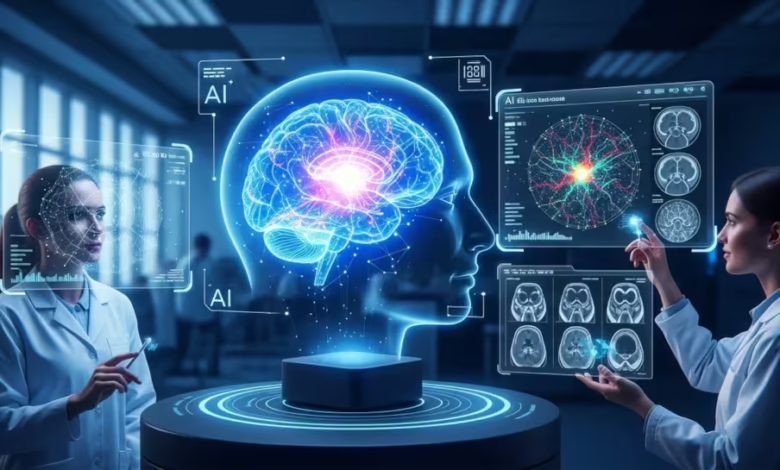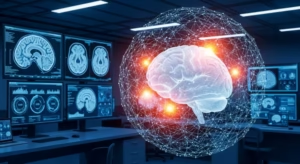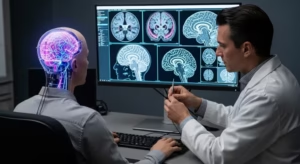NeuroAI: How AI Is Mapping the Human Brain

The blog post titled NeuroAI: How AI Is Mapping the Human Brain explores the transformative potential of Neuro Artificial Intelligence in revolutionizing brain simulation. It delves into the intricate science behind AI neuroscience and how advanced algorithms are being used to create accurate brain maps, enhancing our understanding of neural functions and diseases. The article discusses the methodologies employed in AI-driven brain mapping, showcasing how these innovations are paving the way for breakthroughs in treatments and neuroscience research. As the field progresses, the post outlines future directions in AI brain research, emphasizing the importance of collaboration between neuroscience and AI technologies. Overall, it highlights the promise of NeuroAI in unlocking the mysteries of the human brain and improving mental health outcomes.
Understanding NeuroAI: Revolutionizing Brain Simulation

NeuroAI, an emerging field at the intersection of neuroscience and artificial intelligence, is paving the way for unprecedented advancements in brain simulation. This innovative approach harnesses the capabilities of AI to mimic the complex functions of the human brain, thereby enhancing our understanding of its intricate processes. NeuroAI not only aids in deciphering cognitive functions but also offers solutions for tackling various neurological disorders, providing hope for groundbreaking treatments that were previously inconceivable.
Key Benefits of NeuroAI
- Enhanced Brain Mapping: NeuroAI facilitates the precise mapping of brain functions, leading to better understanding and treatment of neurological conditions.
- Improved Cognitive Research: It allows researchers to simulate cognitive processes, significantly speeding up the study of human behavior and learning.
- Personalized Medicine: Insights gained from NeuroAI can lead to tailored treatment plans based on individual brain data.
- Predictive Modeling: Advanced simulations can foresee potential mental health issues before they develop.
- Rehabilitation Tools: NeuroAI creates tools for cognitive rehabilitation, aiding recovery from brain injuries.
- Interdisciplinary Collaboration: It encourages collaboration among neuroscientists, AI experts, and psychologists, promoting holistic understanding.
As NeuroAI continues to evolve, the implications for both science and medicine are profound. By leveraging the strengths of artificial intelligence in understanding neural activities, researchers can potentially unlock secrets of the brain that have eluded scientists for centuries. The transformative power of NeuroAI not only enriches our knowledge about the brain but also inspires new methodologies for brain simulation, propelling us into an era of unprecedented discovery in neuroscience.
The Science Behind AI Neuroscience and Brain Mapping

AI neuroscience is an emerging field that leverages advanced algorithms and artificial intelligence to explore and map the human brain. By integrating technologies like machine learning and data analysis, researchers are able to develop sophisticated models that mimic cognitive functions. This approach not only enhances our understanding of brain architecture but also helps in identifying how various neural pathways interact. Artificial brain mapping techniques are proving invaluable in deciphering the complex relationships between brain areas, creating new opportunities for both research and clinical applications.
The underpinnings of AI neuroscience rest heavily on intricate models designed to simulate brain functions. These models utilize vast datasets generated from brain imaging techniques, such as fMRI and EEG, allowing for real-time analysis of brain activities. The amalgamation of neuroscience with cutting-edge technology enables scientists to explore phenomena such as neural plasticity and the effects of neurological disorders. The results of this research can lead to significant advancements in mental health treatments and neurorehabilitation.
Applications of AI Neuroscience in Brain Mapping
| Application | Description | Benefits |
|---|---|---|
| Brain-Computer Interfaces | Enables direct communication between the brain and external devices | Improves the quality of life for those with mobility impairments |
| Cognitive Brain Mapping | Maps cognitive functions and brain behavior correlations | Guides targeted interventions in therapy |
| Neurofeedback | Utilizes real-time displays of brain activity for behavioral training | Enhances cognitive control and emotional regulation |
| Predictive Modeling | Forecasts outcomes of neurological conditions based on brain activity | Informs preventive strategies and treatment options |
To dive deeper into the mechanisms of AI neuroscience, it is essential to understand several key techniques. These methodologies not only optimize research but also facilitate breakthroughs in understanding human cognition. By employing these techniques, researchers can achieve more accurate models that mirror real brain functions.
Key Techniques in AI Neuroscience
- Neural network modeling
- Deep learning algorithms
- Data mining for brain imaging
- Reinforcement learning for cognitive tasks
- Statistical analysis of neural data
- Simulation of neural networks
- Integration of multimodal data sources
Neural Network Models
Neural network models are at the heart of AI neuroscience, functioning as computational frameworks that mimic the connectivity and functionality of biological neural networks. These models enable researchers to analyze and visualize brain data in ways that were previously unimaginable. By utilizing various layers of interconnected nodes, neural networks can learn complex patterns associated with cognitive functions, advancing our ability to diagnose and treat neurological diseases.
Real-Life Applications
The real-life applications of AI neuroscience and brain mapping are transforming clinical practice and research paradigms alike. From improving diagnostic accuracy in neurology to developing personalized treatment plans for cognitive disorders, the implications of this technology are profound. By integrating AI with traditional neuroscience, we enhance our capability to tackle some of the most challenging questions about brain functionality and mental health.
Conclusions and Future Directions in AI Brain Research

AI brain research, particularly through the lens of NeuroAI, has unveiled unprecedented insights into the complexities of the human brain. As we stand at the intersection of neuroscience and advanced artificial intelligence, the future promises profound transformations in our understanding of brain functions and structures. This convergence not only aids in mapping neural circuits but also enhances our capacity to develop targeted therapies for various neurological disorders.
To harness the full potential of NeuroAI, researchers must consider several actionable steps that address both the current limitations in technology and the ethical considerations that accompany these advancements. By focusing on collaborative efforts across disciplines, we can ensure that innovations in AI brain research lead to comprehensive and responsible outcomes. Bridging the gap between AI and neuroscience will be imperative in creating accurate models of brain functions and facilitating translational research to clinical applications.
Actionable Steps for Future Research
- Enhance interdisciplinary collaboration between AI specialists and neuroscientists.
- Invest in technology that ensures high-resolution brain imaging and data analysis.
- Develop ethical guidelines for the application of AI in neuroscience.
- Focus on creating open-source platforms to share research findings and methodologies.
- Encourage public engagement and education on NeuroAI applications.
- Search for new algorithms that can better simulate neural processes.
- Monitor and assess the societal impacts of NeuroAI developments.
In summary, advancing AI brain research through NeuroAI not only requires innovative technologies but also a commitment to ethical practices and collaborative frameworks. By implementing these actionable steps, researchers can pave the way for groundbreaking discoveries while prioritizing the welfare of individuals impacted by neurological conditions. As we move forward in this exciting field, the collaboration of diverse expertise will be crucial in unlocking the many mysteries of the human brain.
Briefing Document: NeuroAI – Mapping the Human Brain
I. Summary
This briefing document reviews the transformative potential of NeuroAI, an emerging field at the intersection of neuroscience and artificial intelligence, in revolutionizing brain simulation and enhancing our understanding of neural functions and diseases. NeuroAI utilizes advanced algorithms and AI technologies, such as machine learning and deep learning, to create accurate brain maps, decipher cognitive functions, and develop groundbreaking treatments for neurological disorders. The field promises significant advancements in personalized medicine, predictive modeling for mental health, and cognitive rehabilitation, while also emphasizing the critical need for interdisciplinary collaboration and ethical guidelines to ensure responsible progress.
For similar articles, please visit: AI in Science & Technology
Homepage / humanaifuture.com
🎧 Listen to the Podcast
Want to explore this topic in more depth? Listen to the full podcast for more insights and expert commentary.
▶️ Play on Google DriveNo sign-up needed — just click and listen.
What are the key benefits of using NeuroAI in understanding the brain and treating neurological conditions?
NeuroAI offers several significant benefits: it facilitates precise brain mapping for better understanding and treatment of neurological conditions; it improves cognitive research by simulating cognitive processes, speeding up the study of human behavior; it enables personalized medicine through tailored treatment plans based on individual brain data; it supports predictive modeling to foresee potential mental health issues; it helps create effective tools for cognitive rehabilitation; and it encourages interdisciplinary collaboration among experts in neuroscience, AI, and psychology.
What scientific methodologies and techniques are at the core of AI neuroscience and brain mapping?
The science behind AI neuroscience and brain mapping heavily relies on advanced algorithms and artificial intelligence. Key methodologies include integrating machine learning and data analysis to develop sophisticated models that mimic cognitive functions. Specific techniques involve neural network modeling, deep learning algorithms, data mining for brain imaging (e.g., fMRI and EEG), reinforcement learning for cognitive tasks, statistical analysis of neural data, simulation of neural networks, and the integration of multimodal data sources. These techniques enable real-time analysis of brain activities and the creation of accurate models of brain functions.
How are neural network models particularly important in AI neuroscience?
Neural network models are fundamental to AI neuroscience because they serve as computational frameworks designed to emulate the connectivity and functionality of biological neural networks. By using interconnected nodes arranged in various layers, these models can learn complex patterns from brain data, aiding in the analysis and visualization of neural activities. This capability is crucial for understanding cognitive functions, improving diagnostic accuracy, and advancing the development of treatments for neurological diseases.
What are some real-life applications of AI neuroscience in both research and clinical practice?
The real-life applications of AI neuroscience and brain mapping are transforming both clinical practice and research. These include the development of Brain-Computer Interfaces (BCIs) that enable direct communication between the brain and external devices, significantly improving the quality of life for individuals with mobility impairments. Other applications involve cognitive brain mapping to guide targeted interventions in therapy, neurofeedback for enhancing cognitive control and emotional regulation through real-time displays of brain activity, and predictive modeling to forecast neurological condition outcomes, informing preventive strategies and treatment options.
What are the future directions and actionable steps for advancing AI brain research through NeuroAI?
Future directions in AI brain research, particularly within NeuroAI, emphasize addressing current technological limitations and ethical considerations. Key actionable steps include enhancing interdisciplinary collaboration between AI specialists and neuroscientists, investing in high-resolution brain imaging and data analysis technologies, developing ethical guidelines for AI applications in neuroscience, creating open-source platforms for sharing research, encouraging public engagement and education, searching for new algorithms to better simulate neural processes, and continuously monitoring the societal impacts of NeuroAI developments.
Why is interdisciplinary collaboration crucial for the success of NeuroAI?
Interdisciplinary collaboration between AI specialists, neuroscientists, and psychologists is crucial for the success of NeuroAI because it promotes a holistic understanding of the brain. Bridging the gap between AI and neuroscience ensures that innovations are not only technologically sound but also deeply informed by biological understanding. This collaboration is essential for creating accurate models of brain functions, facilitating the translation of research findings into clinical applications, and addressing the complex ethical considerations that arise with advanced AI in brain research.
How does NeuroAI contribute to improving mental health outcomes?
NeuroAI contributes significantly to improving mental health outcomes by enhancing our understanding of neural functions and diseases. Through precise brain mapping, improved cognitive research, and predictive modeling, NeuroAI can help foresee mental health issues before they fully develop. Furthermore, insights gained from NeuroAI can lead to personalized treatment plans and the development of effective rehabilitation tools for cognitive recovery. By unlocking the mysteries of the human brain, NeuroAI paves the way for groundbreaking treatments and more effective interventions for various neurological and mental health conditions.




